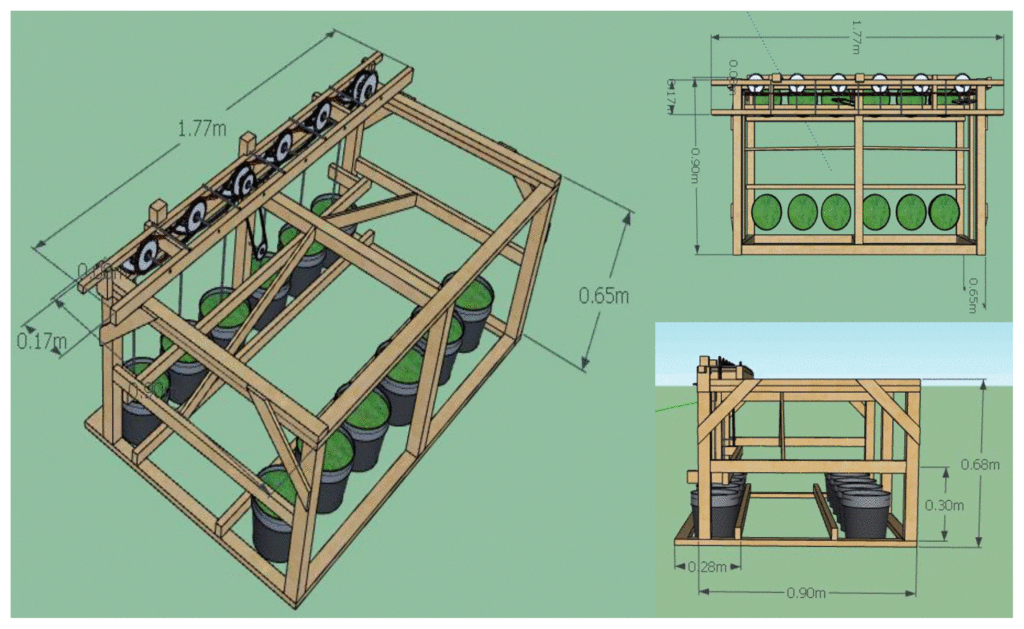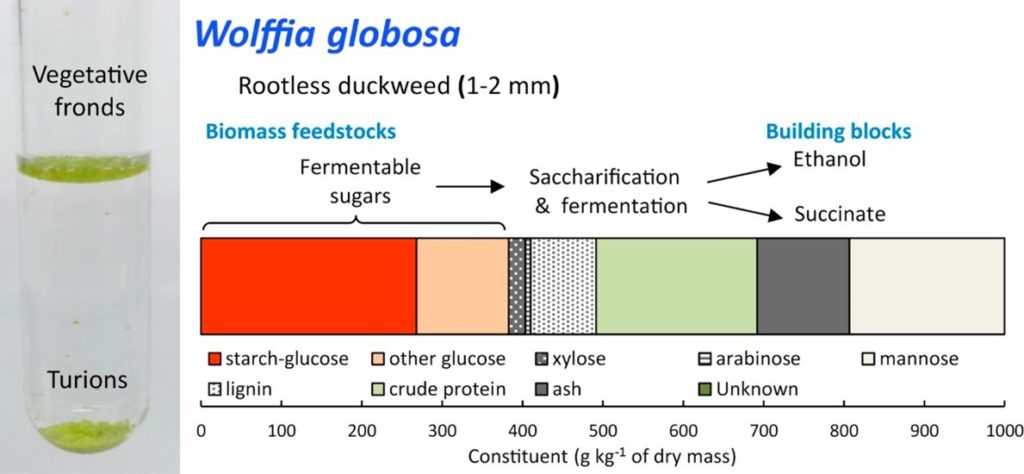Duckweed is the focus of this Florida Native Plant Spotlight. When we think of ways in which we can help the environment we often overlook some of the smallest plant tools to make an environmental change. Common amongst most bodies of freshwater around the world it is becoming increasingly popular when it comes to the environment, authors of “The Duckweed Genomes”4 state in their book that Duckweed can be used for carbon sequestration, Biofuels, and Environmental remediation.

What is Duckweed:
Maxing out at one-centimeter20 Duckweed has shown promise because of some specific characteristics including being fast-growing which led to the plant’s growing reputation19. Duckweed is known as the world’s fastest-growing plant15 and can grow on every continent except Antarctica. This speed allows for it to be an optimal plant for green initiatives like water treatment.
Although this plant is very tiny it has proven to be an extremely valuable food source when considering both people and livestock. According to “The Salk Institute”15 duckweed has great potential as a source for protein.
Roasted Duckweed
To combat the challenges with a constantly growing population in an environmentally friendly way, researchers have turned to many alternative methods of producing food. Factors like Duckweed’s extremely high protein content and speedy growth rate have caused scientists and bloggers alike to refer to this plant as the next superfood9. Eating duckweed may have nutritional benefits, but duckweed’s ability to remove many dangerous metals from the waterways, (lead, copper, zinc, and arsenic, etc.)1 could be present within the duckweed sourced from the wild. Duckweed should only be sourced from companies that practice the safe production of the crop.

Duckweed is often sold cubed or powdered and can be added into many dishes without changing the flavor.23 Many populations within countries like Laos and Myanmar2 have been able to introduce strains of duckweed into their diet to supplement carbohydrates and proteins.6 Duckweed has also already begun to be implemented as a food for many livestock including chicken and fish.17
Duckweed Cleans Rivers
Duckweed joins a long list of plants that are known as hyperaccumulators. Hyperaccumulators or plants with the ability to accrue metals and metalloids within their living tissue. In the case of duckweed, the plant absorbs metals along with nutrients within the water they inhabit. Hyperaccumulators are often referred to when talking about phytoremediation or the use of plants and other natural biology to reduce the harm of toxic contaminants.

Phytoremediation Is an extremely effective way to clean rivers and improve the environment.8 There are large-scale examples of phytoremediation that incorporate a plethora of plants including duckweed all over the world both man-made and natural. For a large-scale example of phytoremediation check out this article about how the City of Orlando uses phytoremediation on a large scale to clean water and boost tourism. For more information read this article: The Ecology of the Orlando Wetlands and Your Next Visit

Carbon Sequestration & Biomass
To reduce the rate of global climate change due to the release of carbon dioxide into the atmosphere, researchers have begun looking into carbon sequestration.17 Duckweed is a plant although very tiny duckweed has a lot of potential for carbon sequestration according to “The production of duckweed as a source of biofuels”25 a review of various studies about the applications of duckweed. Carbon Sequestration is an extremely interesting topic that has proven to be extremely effective, For more information read this article: “How Ecosystem Carbon Capture Could Reverse Global Warming.”.
Duckweed as biomass shows extreme promise because pelletizing it is far easier than traditional materials like wood, making it more cost-effective. According to a 2018 USDA fact sheet about duckweed, the pellets can be converted into biogas, or gas created from organic materials used for energy.17 The biogas created can further be turned into gasoline which would bring competitive pricing compared to oil refineries.17
To quote the conclusion of “Duckweed biomass as a renewable biorefinery feedstock: Ethanol and succinate production from Wolffia globosa”6 a science direct article about using duckweed as biomass, researchers stated, “Duckweed biomass, with its high growth rate and high starch content, can be an excellent feedstock for the production of ethanol and succinate as building block chemicals for the replacement of petrochemicals.”

What Can I Do Next
One of the most important things we as regular citizens can do is embrace the ideas of food alternatives, instead of buying regular protein powder you can buy water lentil powder which is more sustainable than its counterpart. As mentioned earlier growing populations bring challenges when it comes to food scarcity, especially in America we should actively embrace greener alternatives and support companies that are seeking to fight environmental disasters. Lastly, you as citizens can also write to local and state governments to do more research into plants as viable options for phytoremediation and water treatment.

Bibliography:
- Ali, Z., Waheed, H., Kazi, A. G., Hayat, A., & Ahmad, M. (2016). Duckweed: An Efficient Hyperaccumulator of Heavy Metals in Water Bodies. Retrieved from Science Direct: https://doi.org/10.1016/B978-0-12-803158-2.00016-3
- Bates, T. (2019, August 19). Could duckweed feed the world? Retrieved from Phys Org: https://phys.org/news/2019-08-duckweed-world.html
- Bee, P. (2020, November 25). https://www.thetimes.co.uk/article/the-new-kale-why-well-be-drinking-duckweed-in-2021-mdbgcrn9q. Retrieved from The Times: https://www.thetimes.co.uk/article/the-new-kale-why-well-be-drinking-duckweed-in-2021-mdbgcrn9q
- Cao, X. H., Fourounjian, P., & Wang, W. (2020). The Duckweed Genomes. Springer International Publishing AG.
- Deane. (n.d.). Duckweed. Retrieved from Eat the Weeds: http://www.eattheweeds.com/duckweed/
- DUCKWEED: A tiny aquatic plant with enormous potential for agriculture and environment. (n.d.). Retrieved from Food and Agricultural Association: http://www.fao.org/ag/againfo/resources/documents/DW/dw2.htm
- Fact Sheet | Biogas: Converting Waste to Energy. (2017, October 3). Retrieved from Environmental and Energy Study Institute: https://www.eesi.org/papers/view/fact-sheet-biogasconverting-waste-to-energy
- Greipsson, S. (2011). Phytoremediation. Retrieved from The Nature Education Knowledge Project: https://www.nature.com/scitable/knowledge/library/phytoremediation-17359669/#:~:text=Phytoremediation%20basically%20refers%20to%20the,cost%2Deffective%20environmental%20restoration%20technology
- Heard, S. (2021, 03 16). Why duckweed might just be the next new superfood. Retrieved from Stuff: Life & Style: https://www.stuff.co.nz/life-style/well-good/teach-me/124297081/why-duckweed-might-just-be-the-next-new-superfood
- Kreider, A. N., Fernandez Pulido, C. R., Bruns, M. A., & Brennan, R. A. (2019, March). Duckweed as an Agricultural Amendment: Nitrogen Mineralization, Leaching, and Sorghum Uptake. Retrieved from PubMed: National Library of Medicine: https://pubmed.ncbi.nlm.nih.gov/30951113/#:~:text=Duckweed%20(Lemnaceae)%2C%20a%20floating,water%20bodies%20to%20agricultural%20fields
- Nosowitz, D. (2017, January 23). Scientists And Startups Want You To Start Eating…Duckweed? Retrieved from Modern Farmer: https://modernfarmer.com/2017/01/scientists-startups-want-start-eating-duckweed/
- Park, H., Park, J. H., Lee, Y., Woo, D. U., Jeon, H. H., Sung, Y. W., . . . Kang, Y. J. (2021, July 22). Genome of the world’s smallest flowering plant, Wolffia Australiana, helps explain its specialized physiology and unique morphology. Retrieved from Nature: Communications Biology: https://www.nature.com/articles/s42003-021-02422-5#citeas
- Reeves, R. D., Baker, A. M., Jaffré, T., Erskine, P. D., Echevarria, G., & Van der Ent, A. (2017, November 15). A global database for plants that hyperaccumulate metal and metalloid trace elements. Retrieved from New Phytologist Foundation: https://doi.org/10.1111/nph.14907
- Saha, P., Banerjee, A., & Sarkar, S. (2015). Phytoremediation Potential of Duckweed (Lemna Minor L.). Retrieved from PubMed: https://pubmed.ncbi.nlm.nih.gov/25192438/
- Salk. (2021, February 1). RESEARCH CATCHES UP TO WORLD’S FASTEST-GROWING PLANT. Retrieved from Salk: https://www.salk.edu/news-release/research-catches-up-to-worlds-fastest-growing-plant/
- Soda, S., Ohchi, T., Piradee, J., Takai, Y., & Ike, M. (2015, October). Duckweed biomass as a renewable biorefinery feedstock: Ethanol and succinate production from Wolffia globosa. Retrieved from Science Direct: https://www.sciencedirect.com/science/article/pii/S0961953415300593#sec4
- Thangaraj, P., Lam, E., & Hochman, G. (2018, March 12). FactSheet: Duckweed as Biomass; Bioenergy with Carbon Capture. Retrieved from USDA: https://www.usda.gov/sites/default/files/documents/Duckweed_Factsheet.pdf
- Ubuza, L. A., Padero, P. S., Nacalaban, C. N., Tolentino, J. T., Alcoran, D. C., Tolentino, J. C., . . . Arazo, R. O. (2019, november 25). Assessment of the potential of duckweed (Lemna minor L.) in treating lead-contaminated water through phytoremediation in stationary and recirculated set-ups. Retrieved from KSEE; Environmental Engineering Research: https://doi.org/10.4491/eer.2019.258
- University of Florida; Center for Aquatic and Invasive Plants. (2021, October 1). Spirodela Polyrhiza. Retrieved from University of Florida; Center for Aquatic and Invasive Plants: https://plants.ifas.ufl.edu/plant-directory/spirodela-polyrhiza/
- University of South Florida; Institute for Systematic Botany. (2021, October 3). Lemna Minor. Retrieved from University of South Florida; Institute for Systematic Botany: https://florida.plantatlas.usf.edu/plant.aspx?id=3606
- University of South Florida; Institute for Systematic Botany. (n.d.). Lemna. Retrieved from https://florida.plantatlas.usf.edu/Genus.aspx?id=684: https://florida.plantatlas.usf.edu/Genus.aspx?id=684
- Verma, R., & Suthar, S. (2015, December). Lead and cadmium removal from water using duckweed – Lemna gibba L.: Impact of pH and initial metal load. Retrieved from Science Direct: https://doi.org/10.1016/j.aej.2015.09.014
- Would you eat POND WEED? Protein-rich powder made from duckweed could help feed the world. (2015, July 14). Retrieved from Daily Mail: https://www.dailymail.co.uk/sciencetech/article-3161195/Would-eat-pond-scum-Protein-rich-powder-duckweed-help-feed-world.html
- XDD Environmental. (n.d.). Phytoremediation Technologies. Retrieved from XDD EnviromEnvironmental://www.xdd-llc.com/phytoremediation-technologies/
- Xu, J., Zhao, H., Stomp, A.-M., & Cheng, J. (2014, April 09). The production of duckweed as a source of biofuels. Retrieved from Taylor & Francis Online: https://doi.org/10.4155/bfs.12.31
Photo Credits:
- Alphotographic. (2021, February 1). Tree branches in winter over a stream stock photo. Retrieved from Unsplash: https://www.istockphoto.com/photo/tree-branches-in-winter-over-a-stream-gm1299302648-391970733?utm_source=unsplash&utm_medium=affiliate&utm_campaign=srp_photos_top&utm_content=https%3A%2F%2Funsplash.com%2Fs%2Fphotos%2Fduckweed&utm_term=duckweed%3A%3Asearc
- Daily Mail. (2021). Lentein powder (pictured) is 68 percent protein and is made from duckweed, a common plant that floats on the surface of ponds and lakes. Retrieved from https://i.dailymail.co.uk/i/pix/2015/07/14/18/2A8753D000000578-3161195-image-a-18_1436893877059.jpg
- Mitrprayoon, A. (2018, November 20). Duckweed In Water. Retrieved from Unsplash: https://media.istockphoto.com/photos/duckweed-in-water-picture-id1069972126?b=1&k=20&m=1069972126&s=170667a&w=0&h=ijL8PnAn0hyDykAB90INGgzY1GqmT12HElRZkg3OgVM=
- Phytoremediation InfoGraphic. (n.d.). Retrieved from XDD Environmental: https://www.xdd-llc.com/__trashed-5/attachment/phytoremediation/
- Sikkema, K. (2020, October 1). Green bullfrog sitting in a still pond of duckweed. Retrieved from Unsplash: https://images.unsplash.com/photo-1601585463546-7e7bf29c834c?ixid=MnwxMjA3fDB8MHxzZWFyY2h8NXx8ZHVja3dlZWR8ZW58MHx8MHx8&ixlib=rb-1.2.1&auto=format&fit=crop&w=500&q=60
- Soda, S., Ohchi, T., Piradee, J., Takai, Y., & Ike, M. (2015, October). (Graphical Abstract) Duckweed biomass as a renewable biorefinery feedstock: Ethanol and succinate production from Wolffia globosa. Retrieved from Science Direct: https://doi.org/10.1016/j.biombioe.2015.07.020
- Sorrels, S. (2021). Chicken with duckweed. Retrieved from Phys Org; Could duckweed feed the world?: https://scx1.b-cdn.net/csz/news/800a/2019/2-couldduckwee.jpg
- Tran, K. (2019, June 16). Fern and Duckweed. Retrieved from Unsplash: https://unsplash.com/photos/-xFV6TYIMyU
- Verma, R., & Suthar, S. (2015, December). Lead and cadmium removal from water using duckweed – Lemna gibba L.: Impact of pH and initial metal load. Retrieved from Science Direct: https://doi.org/10.1016/j.aej.2015.09.014
- Warren, M. (2020, November 13). Black Bellied Whistling Ducks Feeding. Retrieved from Unsplash: https://www.istockphoto.com/photo/black-bellied-whistling-ducks-feeding-gm1285355935-382220244?utm_source=unsplash&utm_medium=affiliate&utm_campaign=srp_photos_top&utm_content=https%3A%2F%2Funsplash.com%2Fs%2Fphotos%2Fduckweed&utm_term=duckweed%3A%3Asearc








